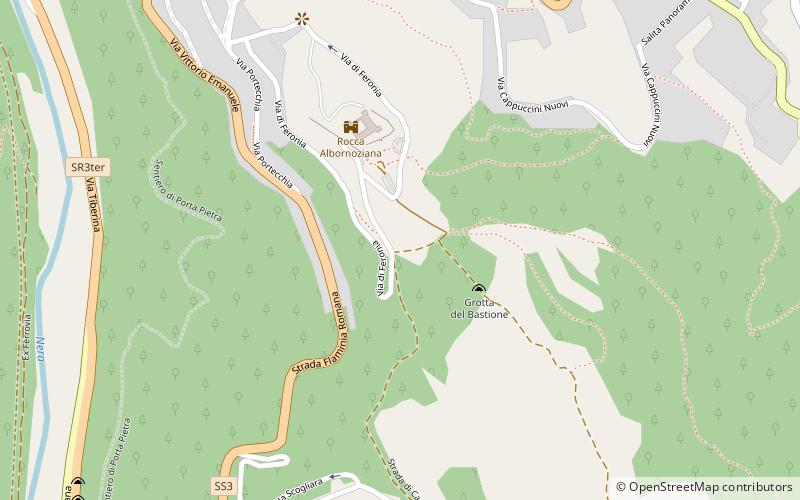Fonte Feronia, Narni


Facts and practical information
The spring of Feronia is a water source of pre-Roman origin located in Narni. It was dedicated to the goddess Feronia who, in the Narni of the time, enjoyed such worship and respect that she was venerated not only by the Umbrians but also among the Etruscans, Volscians and Sabines. The spring's water, now declared undrinkable and uncontrolled, was highly prized by the Nequinatians for its characteristics of purity and lightness. Characteristics that took the ancient inhabitants far away from the center of city life, thus becoming a destination for pilgrimages in honor of the goddess who, among other virtues, represented eternal springtime and water purity. The original temple, the statue of Feronia and the sacred forest of shady elks were destroyed by the early Narnese Christians. As a consequence that place, considered sacred until recently, was called "maccla mortua." The first historical indication of the site is in 1100, as can be seen from the writing Liber gemniagraphus sive cleronomialis Ecclesiae Farfensis, better known by the name of Regestum Farfense written by Gregory of Catino in 1128, where it is reported the will of a nobleman from Narnia, Beraldo di Rolando, who donated all his property to the Abbey of Farfa except for the "maccla mortua quae vocatur Ferone."
In the statutes of Narni there are several quotations referring to Porta Feronia and the Feronia spring. In Chapter 143 of Book 111 it can be read "it is enjoined that no offense be done to the women who go to draw water from the spring of Feronia, both on the way there and on the way back." The Hungarian poet Janus Pannonius, finding himself passing through Narni in 1458, found inspiration in quenching his thirst from the spring's waters, thus writing an elegant Latin poem entitled "Carmen de fonte narniensi" here given in its Latin version : Sacri fontis ave, mater Feronia, cuius felix Paeonias Narnia potat aquas. Iam prope litorei tetigit sol brachia cancri, sentit et Icarium fervida terra canem. Tolle sitim; saevis tulerat Langia Pelasgis, quae nostra exurit pectora, tolle sitim. Sic tibi magna parens alimenta aeterna ministret, sic nunquam vena pauperiore fluas! En semel, en iterum, quos ferrea fistula fundit, excipiunt latices guttura sicca tuos. O quantus rediit membris vigor, o mea quanto viscera divinus liberat igne liquor! Nec venter, quamvis repetito immurmurat haustu, sudorem subitum nec gravis humor agit. Ergo operae nobis pretium fuit alta labantis ad iuga clivoso tramite ferre gradus. Iam libet et pulchram mirari turribus arcem, quae surgit sanctis proxima gurgitibus, audire et strepitum, quem subter valle profunda spumea sulfurei fluminis unda facit, ac totos circum-lustrare ex ordine montis, pura salutiferi quos fovet aura poli. Ante voluptatem spectacula nulla movebant, cum premeret torrens ora perusta vapor. Ocius huc adsit toto grege pinguior haedus, mutet et effusus vitrea stagna cruor. Adsint et liquido Bacchi cum munere flores, nec cesset laudes vox resonare pias: salve iterum e Latiis longe celeberrima Nymphis, hospitis et grati suscipe dona libens. Tu placidam miseris requiem mortalibus affers corpora morosis febribus aegra levans. Nec soli debent homines tibi, debet at aether, aurea cum pascas roribus astra tuis. Phryx puer haud alias miscet cum nectare lymphas, nec sua Mars alio vulnera fonte lavat. Debita solventur semper tibi vota quotannis, dum mea vitalis spiritus ossa reget. Nec plus Castalias, quam te, venerabimus undas, Musarum et nobis numinis instar eris. Sed tamen in fessas unde haec medicina medullas, omnia quae nostis, dicite, quaeso, deae. Euander ternis Herilum spoliaverat armis, crudeles genitrix invocat orba deos. Iupiter est flentem caelo miseratus ab alto, corpus et in tenues iussit abire lacus, nec voluit rivis esse ex vulgaribus unum, sed superis magno fecit honore parem. Praecipua hinc levitas, hinc vis contraria morbis, hinc clarum tota nomen in Ausonia.
In 1582 the spring was subjected to restoration at the behest of Monsignor Giulio Ranuzi governor of Narni, presumably completed in 1609 as reported on the plaque inside the spring. In 1851 the Narni historian Giovanni Eroli commissioned the University of Perugia to conduct an analysis of the spring's water, which returned the following answer "With good reason the water known as Feronia is in reputation among potable waters, since it enjoys to the highest degree the principal requirements of which deggion the potable waters be provided, those being that of containing much oxygen and very little dose of other dissolving substances."
The local speleological group carried out, around 1984, exploratory surveys inside the tunnel of the ancient source dating it, in terms of characteristics and construction techniques, between the fourth century B.C. and the third century B.C. The temporal placement of the artifact corroborates the thesis of the place of pagan worship already expressed around the end of 1800 by Giovanni Cotogni of Narni " Among the other temples that existed in Narni by the superstition of the gentiles applied to false deities was that of the Luco and Fonte di Feronia in today with altered name said that site Ferogna. There probably, as in some other places, Gravi the temple and statue of the goddess Feronia being there also presently a marble in that fountain in which is carved a great flame perhaps the insignia of that ancient vanity. The truth is that that fountain having transit by esteemed mines is of a very salubrious water, and greatly held in esteem both as to its rare limpidity, and for the prerogative that it has of easy digestion."
In 1997, funded by the foundation of a local lending institution, the fountain was again restored from its characteristic stone walls to a more anonymous, and certainly less striking, plaster.
Narni
Fonte Feronia – popular in the area (distance from the attraction)
Nearby attractions include: Church of San Domenico, Bridge of Augustus, Abbey of San Cassiano, Santa Maria Impensole.











